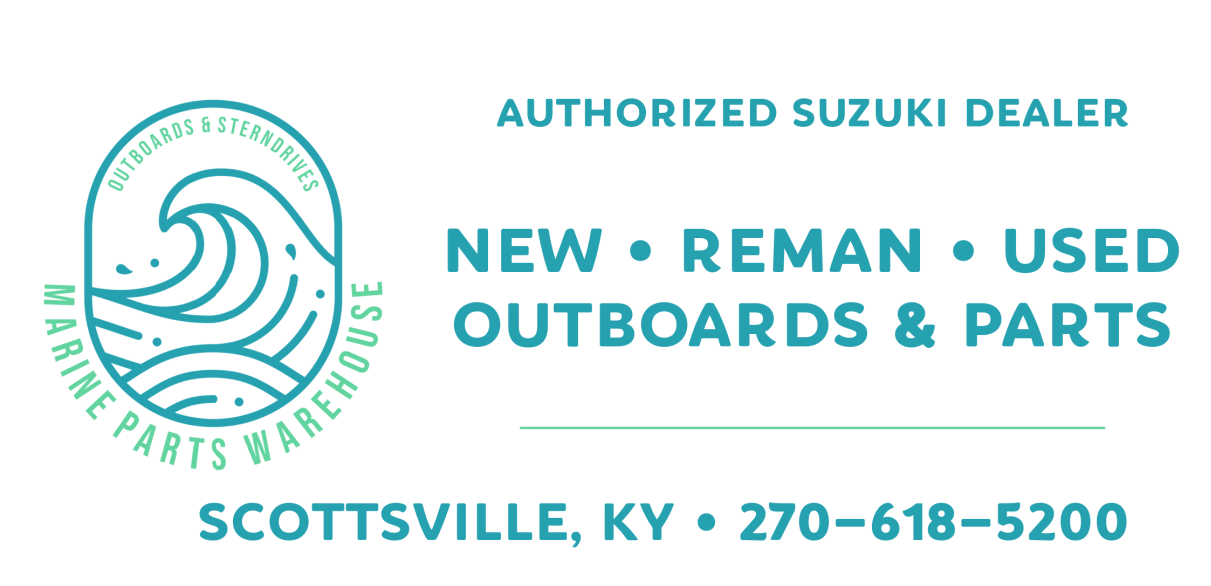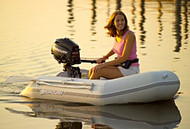Choosing an Outboard Engine for Your Boat
Two of the most indispensable items on board a cruising yacht are a dinghy and an outboard motor. At anchor or on a buoy, of course, they are your only means of getting ashore. They also have a thousand other uses. For example, they can allow you to motor across to friends’ boats, collect supplies, clean the hull, feed out a long line ashore or set a kedge anchor, just to name a few.
With this in mind, not only does the tender need to be tough and stable, its outboard motor must be as reliable as possible and powerful enough to drive it fully loaded, but not so heavy it can’t be handled on and off the boat easily and safely. There is a large selection of portable outboards available, but first, you need to decide which type would best suit your purposes.
Marine Parts Warehouse is here to help you pick the right outboard for your boat. Please click HERE to see what engines we current have available.
Size and weight Clearly, the maximum size of outboard you can go with will depend primarily on the size and type of tender you choose. Many 35-45ft blue water cruisers will have a 9-10ft inflatable or RIB for general-purpose tender use. However, the specific make and model you buy can also depend on the size of yacht you have and your means of stowing it onboard.
A 10ft inflatable can usually support a 6-8hp outboard, whereas a similarly sized RIB can take a 10-15hp model, thereby enabling you to plane with a couple of adults on board. You won’t be able to water ski with either of these rigs, but there are times when having the extra power to go greater distances quickly is a bonus.
Another important factor in deciding which size motor to buy is its weight. If you’re likely to be taking the motor on and off the yacht frequently, then you’ll need to compromise between power and poundage. It’s worth noting that many of the components and engines on portable outboards are the same inside, despite having different horsepower ratings.
For instance, most 4hp motors are the same as the 6hp version, only with restricted carburetors to lower the power. It follows, then, that they both weigh pretty much the same, so unless there’s another good reason for not buying the higher power model (price or features maybe) you might as well grab the extra oomph without the weight penalty.
Owing to the extra mechanical parts a four-stroke often weighs in at twice the heft of a two-stroke. This, in turn, means getting the engine onto the transom of a tender and back again can be fraught with danger—both to your back and to the engine. Because of this, however, the market in older but well-maintained two-strokes is going through the roof, resulting in many of them being priced close to the level of a much newer four-stroke.
A sensible weight of outboard for one person to carry is no more than 65lb, which equates to a 4/6hp single-cylinder model. Perhaps you can tote an 8/10hp (85lb) two-cylinder motor if you’re young, fit and strong. But be warned: these kinds of larger engines are tough to get on and off the mothership without a tackle. For this reason, you might well be better off looking for a less powerful, smaller outboard if you’re planning to buy new.
Good-old Gas
For decades now, gas-powered outboard engines have been the best way to propel a small tender. They’re fairly straightforward to use and maintain, even when you’re at sea or anchored in some far-flung destination. More recently, one of the biggest changes to outboards has been the move from two-stroke to four-stroke engines, in the interest of reducing exhaust emissions. Despite the extra weight, a four-stroke offers certain other benefits as well. They’re quieter, for example, less thirsty, tick over more smoothly and you don’t need to mix up large quantities of oil and gas.
That said, they also require laying down carefully to stop oil seepage, have more components to fail and are more complicated and expensive to service.
Pros and Cons of LPG
In the past, a few companies would sometimes modify certain gas outboards to use propane. However, the modifications were expensive. Then came the U.S. company Lehr, which introduced a range of propane-powered outboards that now includes five models offering 2.5, 5, 9.9, 15 and 25hp. Following in Lehr’s wake, Tohatsu/Mercury has also brought out a new 5hp propane outboard.
Propane outboards are much like their regular gas counterparts, only with a different carburation setup and employing a pressurized LPG tank—either a simple screw-in canister in the case of Lehr or a larger remote bottle. (Lehrs can also be run using a remote canister.)
Over time, propane outboards have proven to be pretty much as reliable and efficient as their gas equivalents at the same time they also emit fewer harmful exhaust gases (although they can sometimes be harder to start in extreme weather when the LPG becomes more liquid). Priced about the same, another advantage over a gas engine is that they never encounter problems with fuel quality, in stark contrast to gas, which now that it contains a large quantity of ethanol (biofuel), can block up the fuel filter and carburetor jets after a few months of use.
A propane outboard also can’t be flooded the way a regular gas outboard can (and frequently does). Not unlike a regular gas outboard with an integral gas tank, a 16oz canister offers around two hours of running at half throttle with a Lehr. This same canister can then be easily changed out on passage. In practice, the main downside of running a Lehr off canisters is you need to source and store (on deck or in a suitably designed locker) a large number of compatible canisters, as the specific types are not always freely available abroad. Although you can buy a special adapter that will enable you to refill the canisters from a larger propane tank when on a stable platform, this can be somewhat tricky to do and poses a fire hazard.
The lack of a visible indication of fuel remaining in and LPG tank can also be annoying, although as stated, changing the canister on a Lehr outboard, in particular, is quick, clean and easy. As with most four-stroke gas outboards, you also need to take care how you lie the motor down due to the crankcase oil.
The Electric Outboard
Despite it being over a decade since the first feasible and reliable electric outboard was launched, there are still very few that can seriously be considered a viable tender outboard. Yes, there are hundreds of Asian-built electric trolling motors around, but rarely do they produce more than 0.5hp. In addition, few of these smaller motors are genuinely seawater-proof except, maybe, the Minn Kota Riptide range. Then there is the fact that the more powerful models require a large battery that is both cumbersome and tedious to keep charged and stow.
Fortunately, there are now a few electric motors that genuinely make the grade, including German-built Torqeedo, the Chinese-made E-Propulsion range and EP Carry. All three lines of outboards employ an integral, rechargeable Lithium battery pack that can be removed for charging and, in the case of E-Propulsion and EP Carry, floats. The latest 3hp equivalents of the Torqeedo, the 1003C and 1100C, have a 915 Watt-hour (Wh) Lithium battery that can push up to 3,300 lb of dinghy along at somewhere between 5-8 knots, while E-Propulsion’s Spirit 1.0 outboard has a capacity of 1,276Wh The Lithium battery on the lighter (21lb) EP Carry has a 230Wh capacity—just enough for around an hour or two’s motoring at half throttle on a lightweight dinghy.
In terms of price, the Torqeedo retails for around $2,500 and the EP Spirit retails for around $2,000, while the EP Carry goes for about $1,600. Of course, a budget Chinese troller can be had for far less (as little as $250, plus battery). But again, the Torqeedo, EP Carry and E-Propulsion motors have been specifically designed and built for cruising tenders and as such are lightweight, waterproof and in the case of Torqeedo and E-Propulsion include such features as an inbuilt remaining charge/range indicator and safety kill switch.
The Torqeedo even has a GPS that shows your speed and distance traveled. In other words, you get what you pay for. Of course, in addition to being wonderfully quiet, electric outboards don’t require refilling with inflammable gas, have no arm-wrenching pull-start or choke, no water pump and impeller, no gearbox or spark plugs (easy and cheap to maintain), need no oil/oil changes (less mess), emit no nasty fumes, and can be laid down how you like without the danger of gas or oil leaking into your trunk or cockpit locker.
Power is also instant, and there is no requirement to warm them up before leaving the dock. In terms of range—a concern for many—higher-quality lithium-powered models can be discharged much further than a cheapy lead-acid powered trolling motor, meaning they can run up to 3-4 hours at half-throttle with a range of around 10-12 miles. In calm, non-tidal waters this can even be extended to 15 miles in a small inflatable, if you’re very gentle on the throttle. When recharging a Lithium-powered outboards it’s best to use the AC charger supplied as that contains a specific Battery Management System (BMS) for that type of cell. Charging times are around 10 hours. Both Torqeedo and E-Propulsion offer a 12DC charger option, but it takes substantially more time than the AC charger.
Other Things to Look At
Shaft Length: Most small outboards are available with a choice of two or three different length shafts. For the average inflatable, a short shaft is fine. Longer shafts are really designed for high-transomed, rigid fishing craft or small sailboats. Note that electric outboards tend to have longer shafts than gas motors in order to ensure the prop doesn’t cavitate due to the instant power.
Propellers: Manufacturers will offer a choice of props, but usually recommend a relatively shallow pitched one for general tender use. Sailboat outboards will normally be supplied with a deeper pitch prop for more drive at lower rpm and better displacement when stopping or reversing.
Gearing: In a small dinghy, having a side-mounted gear shift doesn’t usually cause any problems. However, it’s often easier to use a front-mounted gear shift when the motor is hard to reach. Smaller 2-3hp motors often only have forward and neutral (F-N), requiring you to rotate the entire outboard through 180 degrees to go astern. This can make things a bit tricky when you’re coming alongside and need engine power for stopping quickly.
Throttle: All modern portable outboards now come equipped with twist-grip throttles on the tiller. Electric models also have a forward-neutral-reverse (F-N-R) selector on the tiller that selects the direction of travel by simply turning the grip clockwise or counterclockwise, with neutral being between the two.
Shallow water drive: Pretty much standard on all small outboards, this feature allows the leg to pop up in the event of a grounding. On a model with a reverse gear this should also automatically lock the leg to prevent it lifting when going astern.
TIPS
• If you want a remote gas tank for increased range, you’ll have to buy a 4hp or larger motor.
• Likewise, you need a 4hp or larger motor if you require a reverse gear.
• Having the gear lever easily accessible makes maneuvering in choppy waters a lot easier and safer.
• If you buy a 10hp or larger motor, fit a motor crane on your stern for safer launch and recovery.
• To get a 9ft RIB on a plane with three adults on board you’ll need a 15hp motor minimum, which is, frankly, way too big for general-purpose tender use.
To see all of our new outboard engines contact us today!
Posted by StewBall


